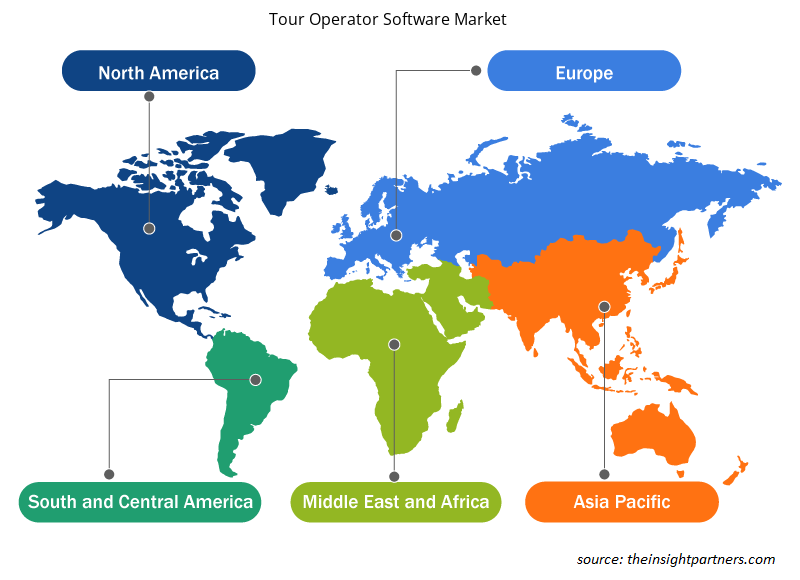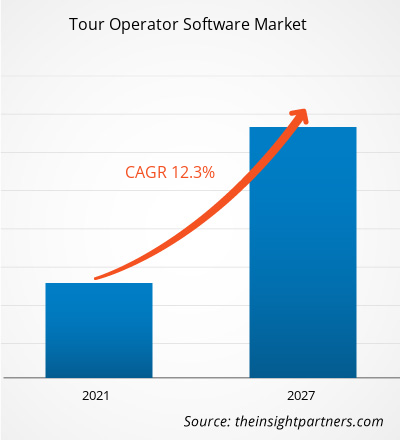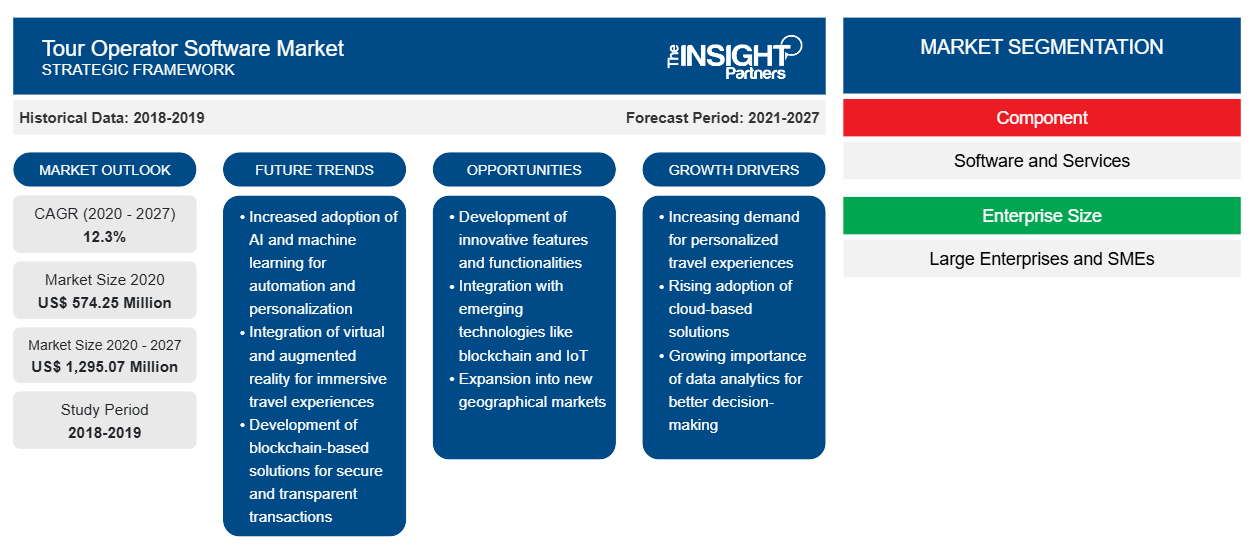Si prevede che il mercato del software per tour operator crescerà da 574,25 milioni di dollari nel 2020 a 1.295,07 milioni di dollari entro il 2027; si stima che crescerà a un CAGR del 12,3% dal 2020 al 2027.
L'industria turistica in crescita a livello globale con prospettive economiche positive è attribuita alla crescita del mercato. La crescita del settore turistico è influenzata da fattori quali la crescita del PIL, le dimensioni dell'economia, lo sviluppo delle infrastrutture di viaggio, il mix di settore, la popolazione e le politiche normative. Questi fattori variano da un paese all'altro e influenzano gli investimenti di viaggio in quel particolare paese. L'industria del turismo ha avuto uno straordinario impulso nel corso degli anni ed è in costante crescita. La domanda di turismo tra ogni classe della società ha portato all'emergere di vari tipi di turismo, come il turismo su strada, il turismo via acqua e il turismo aereo, tra cui il turismo su strada ha dominato il settore per un lungo periodo. L'aumento del reddito disponibile tra le masse nei paesi sviluppati e in via di sviluppo ha portato a una crescente adozione di tour operator per prenotare il loro tour optando per offerte affascinanti. Inoltre, si prevede che la crescita del PIL nei paesi in via di sviluppo come Cina e India offrirà ampie opportunità per la crescita del mercato nei prossimi anni. Con prospettive economiche globali positive, investimenti in infrastrutture di viaggio, crescita delle PMI, enormi volumi di commercio transfrontaliero e condizioni politiche stabilizzanti, si prevede che la spesa per il turismo aumenterà nei prossimi anni in tutto il mondo. Con la crescente globalizzazione e il commercio transfrontaliero, anche la spesa per il turismo sta aumentando. Questi fattori hanno avuto un impatto positivo sulla crescita del mercato del software per tour operator.
Personalizza questo report in base alle tue esigenze
Riceverai la personalizzazione gratuita di qualsiasi report, comprese parti di questo report, o analisi a livello nazionale, pacchetto dati Excel, oltre a usufruire di grandi offerte e sconti per start-up e università
-
Scopri le principali tendenze di mercato in questo rapporto.Questo campione GRATUITO includerà analisi di dati che spaziano dalle tendenze di mercato alle stime e alle previsioni.
Impatto della pandemia di COVID-19 sul mercato del software per tour operator
L'emergere e la rapida diffusione del coronavirus (COVID-19) ha paralizzato numerosi paesi, sia sviluppati che in via di sviluppo. Il continuo aumento del numero di pazienti infetti sta minacciando diversi settori in tutto il mondo. A dicembre 2020, Stati Uniti, India, Brasile, Russia e Francia sono alcuni dei paesi più colpiti in termini di casi confermati e decessi segnalati. L'epidemia di coronavirus ha colpito economie e settori in vari paesi a causa di blocchi, divieti di viaggio e chiusure aziendali. Poiché la maggior parte dei paesi sta esercitando blocchi, il che ha avuto un impatto negativo sul settore dei viaggi e del turismo. Le restrizioni temporanee sui viaggi nazionali e internazionali da parte del governo di diverse regioni stanno anche mostrando un trend negativo nel settore del turismo. La continuità della diffusione del COVID-19 sarebbe gravemente pericolosa per gli operatori del mercato del software per tour operator .
Approfondimenti di mercato - Mercato del software per tour operator
Crescente adozione dell'intelligenza artificiale nel settore turistico
La crescente integrazione dell'intelligenza artificiale (IA) per il miglioramento del processo complessivo di prenotazione di pacchetti turistici interessanti tramite gli operatori, che sta aumentando l'adozione di software per tour operator. L'adozione di IA e robotica nel settore del turismo sta aumentando l'esperienza del cliente e i servizi offerti dal tour operator. Con l'introduzione dell'intelligenza artificiale di viaggio, le disposizioni di viaggio per il passeggero vengono ulteriormente migliorate per soddisfare le sue aspettative. Offre inoltre servizi di viaggio superiori, personalizzati, automatizzati e approfonditi. L'integrazione dell'IA consente ai tour operator di studiare gli interessi e i comportamenti dei viaggiatori e di offrire un'esperienza migliorata. L'IA nel settore dei viaggi e del turismo si concentra principalmente sul coinvolgimento e sul servizio del cliente, per aumentare ulteriormente l'esperienza di viaggio dei viaggiatori. Le tecnologie AI emergenti, come Chatbot, traduttori di lingue e realtà virtuale nei settori del turismo, stanno influenzando positivamente il settore dei viaggi, del turismo e dell'ospitalità. Pertanto, la crescente integrazione dell'IA sta aumentando ulteriormente il settore del turismo in tutto il mondo.
Approfondimenti basati sui componenti
In base al componente, il mercato del software per tour operator è segmentato in software e servizi. Il segmento software ha detenuto la quota di mercato maggiore nel 2019.
Gli operatori che operano nel mercato del software per tour operator si concentrano principalmente sullo sviluppo di prodotti avanzati ed efficienti.
- Nel 2020, GP Solutions GmbH e ComBtas hanno stabilito una partnership strategica. Questa alleanza è destinata ai clienti presenti nel mercato israeliano. Con questa collaborazione, ComBtas promuoverà i prodotti chiavi in mano di GP Solutions, tra cui GP travel enterprise e GP travel hub.
- Nel 2020, Travefy, Inc. ha lanciato un website builder per i consulenti di viaggio. Il website builder consente ai consulenti di creare siti web o una landing page di marketing. Il website builder utilizza un'interfaccia drag and drop e i consulenti possono scegliere un tema, personalizzare il contenuto e possono essere utilizzati URL personalizzati. Inoltre, lo strumento è incluso nel piano di abbonamento.
Approfondimenti regionali sul mercato del software per tour operator
Le tendenze regionali e i fattori che influenzano il mercato del software per tour operator durante il periodo di previsione sono stati ampiamente spiegati dagli analisti di Insight Partners. Questa sezione discute anche i segmenti e la geografia del mercato del software per tour operator in Nord America, Europa, Asia Pacifico, Medio Oriente e Africa e Sud e Centro America.

- Ottieni i dati specifici regionali per il mercato del software per tour operator
Ambito del rapporto di mercato del software per tour operator
| Attributo del report | Dettagli |
|---|---|
| Dimensioni del mercato nel 2020 | 574,25 milioni di dollari USA |
| Dimensioni del mercato entro il 2027 | 1.295,07 milioni di dollari USA |
| CAGR globale (2020 - 2027) | 12,3% |
| Dati storici | 2018-2019 |
| Periodo di previsione | 2021-2027 |
| Segmenti coperti |
Per componente
|
| Regioni e Paesi coperti |
America del Nord
|
| Leader di mercato e profili aziendali chiave |
|
Densità dei player del mercato del software per tour operator: comprendere il suo impatto sulle dinamiche aziendali
Il mercato del software per tour operator sta crescendo rapidamente, spinto dalla crescente domanda degli utenti finali dovuta a fattori quali l'evoluzione delle preferenze dei consumatori, i progressi tecnologici e una maggiore consapevolezza dei vantaggi del prodotto. Con l'aumento della domanda, le aziende stanno ampliando le loro offerte, innovando per soddisfare le esigenze dei consumatori e capitalizzando sulle tendenze emergenti, il che alimenta ulteriormente la crescita del mercato.
La densità degli operatori di mercato si riferisce alla distribuzione di aziende o società che operano in un particolare mercato o settore. Indica quanti concorrenti (operatori di mercato) sono presenti in un dato spazio di mercato in relazione alle sue dimensioni o al valore di mercato totale.
Le principali aziende che operano nel mercato del software per tour operator sono:
- Checkfront Inc
- Soluzioni GP GmbH
- Rezdy
- Programma del tour
- Italiano:
Disclaimer : le aziende elencate sopra non sono classificate secondo un ordine particolare.

- Ottieni una panoramica dei principali attori del mercato dei software per tour operator
Il mercato del software per tour operator è stato segmentato come segue:
Mercato globale del software per tour operator – per componente
- Software
- Servizi
Mercato globale del software per tour operator – per dimensione aziendale
- Grandi Imprese
- PMI
Mercato globale del software per tour operator – per tipo di abbonamento
- Abbonamento una tantum
- Abbonamento mensile
- Abbonamento annuale
Mercato globale del software per tour operator – per area geografica
-
America del Nord
- NOI
- Canada
- Messico
-
Europa
- Francia
- Germania
- Italia
- Russia
- Regno Unito
- Resto d'Europa
-
Asia Pacifico (APAC)
- Giappone
- Cina
- Australia
- India
- Corea del Sud
- Resto dell'APAC
-
Medio Oriente e Africa (MEA)
- Arabia Saudita
- Emirati Arabi Uniti
- Sudafrica
- Resto del MEA
-
America del Sud (SAM)
- Brasile
- Argentina
- Resto del SAM
Mercato del software per tour operator – Profili aziendali
- Checkfront Inc
- Soluzioni GP GmbH
- Rezdy
- Programma del tour
- Italiano:
- ViaggiaPro
- Azienda
- TrekkSoft (gruppo TrekkSoft)
- Italiano:
- Xola, Inc.
- Analisi storica (2 anni), anno base, previsione (7 anni) con CAGR
- Analisi PEST e SWOT
- Valore/volume delle dimensioni del mercato - Globale, Regionale, Nazionale
- Industria e panorama competitivo
- Set di dati Excel
Report recenti
Rapporti correlati
Testimonianze
Motivo dell'acquisto
- Processo decisionale informato
- Comprensione delle dinamiche di mercato
- Analisi competitiva
- Analisi dei clienti
- Previsioni di mercato
- Mitigazione del rischio
- Pianificazione strategica
- Giustificazione degli investimenti
- Identificazione dei mercati emergenti
- Miglioramento delle strategie di marketing
- Aumento dell'efficienza operativa
- Allineamento alle tendenze normative























 Ottieni un campione gratuito per - Mercato del software per tour operator
Ottieni un campione gratuito per - Mercato del software per tour operator